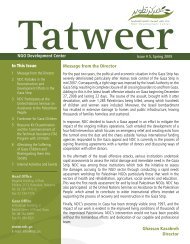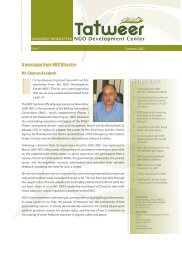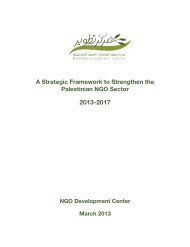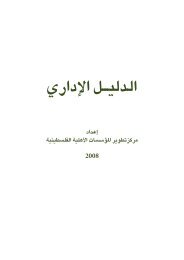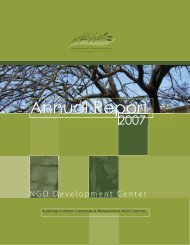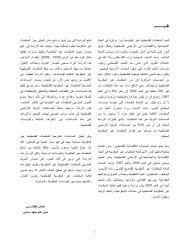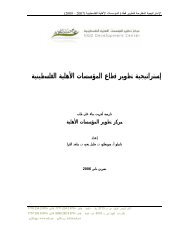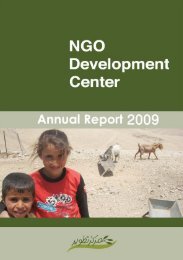Tracking External Donor Funding.pdf - NDC
Tracking External Donor Funding.pdf - NDC
Tracking External Donor Funding.pdf - NDC
You also want an ePaper? Increase the reach of your titles
YUMPU automatically turns print PDFs into web optimized ePapers that Google loves.
Figure 38: The Location of International <strong>Donor</strong>s’ Partner PNGO HQs<br />
versus the Location of <strong>External</strong>ly Funded PNGO Project by Region (2008)<br />
40%<br />
35%<br />
30%<br />
25%<br />
20%<br />
15%<br />
10%<br />
5%<br />
0%<br />
34%<br />
32%<br />
29%<br />
24%<br />
21%<br />
22%<br />
19% 20%<br />
N WB C WB S WB GS<br />
PNGO Distribution<br />
<strong>Donor</strong> Project Distribution<br />
Source: MAS, 2009 – <strong>Donor</strong> Survey. Population: PCBS 2007 Census.<br />
Note: Percentges are rounded to the nearest whole number.<br />
In the Northern West Bank, where 24.3% of Palestinians<br />
live, and where over 29% of PNGOs are headquartered,<br />
only 20.5% of externally financed projects are<br />
implemented. In the Gaza Strip the disparity is much<br />
greater. With a total of 39% of the Palestinian<br />
population and 31.5 percent of the total PNGOs, only<br />
21.6% of externally funding to PNGO activities are<br />
implemented there 48 .<br />
The following Figure compares the location of<br />
international donors' PNGO partners with the location of<br />
their project implementation<br />
While the Figure above provides only a snapshot of the<br />
geographic distribution of international donor funded<br />
PNGO projects, the Figure below shows how this has<br />
changed over the ten-year period.. According to our<br />
survey, the Gaza Strip received a much higher<br />
proportion of international aid in the late 1990's, until<br />
peaking in 2000 at just over 60% of total aid 49 . In 2001,<br />
with the onset of the Second Intifada, the percentage of<br />
internationally funded PNGO projects in Gaza falls<br />
dramatically, nearly 20%, before stabilizing between<br />
23% and 30% from 2002 onward.<br />
Internationally funded PNGO projects remained<br />
relatively stable throughout the ten years studied,<br />
remaining between 19% and 27% throughout, with the<br />
exception of a slight decline in 2000. By 2008, the NWB<br />
was the beneficiary of nearly the same percentage of<br />
international funding as the GS, despite being home to<br />
15% less of the of the Palestinian population.<br />
The Central West Bank hosts the highest proportion of<br />
internationally funded PNGO projects, despite being the<br />
home to the smallest percentage of the Palestinian<br />
population. According to our study, there is a dramatic<br />
increase (nearly 15%) in the percentage of projects<br />
implemented in the CWB between 2001 and 2002,<br />
correlating very closely with the dramatic decline in the<br />
GS over the same period. From 2002 onward, the<br />
percentage of internationally funded PNGO projects<br />
implemented in the CWB remains stable at or slightly<br />
above 30% of the total. There is a slight dip in 2005,<br />
once more seeming to correspond with a slight rise in the<br />
GS.<br />
The Southern West Bank was the location of<br />
implementation of nearly 10% of externally funded<br />
PNGO projects between 1999 and 2001, before climbing<br />
to nearly 20% in 2002. From 2002 to 2008, the<br />
percentage remains stable around 20% of the total.<br />
In terms of the different types of donors studied, INGO<br />
donors give a higher percentage of their aid to the NWB,<br />
less than the average to the CWB, noticeably less to the<br />
SWB and more to the GS than the average. Between<br />
2007 and 2008, funding for project implementation in the<br />
GS increased by 5% among INGO donors. Governmental<br />
donors, on the other hand, devote over 34% of their<br />
funding to projects implemented in the CWB.<br />
48<br />
49<br />
As the following sections will show, the low percentage of international aid to PNGOs in Gaza has not resulted from the 2007 takeover by<br />
Hamas, but has remained consistently low since 2002.<br />
However, these earlier years of data are biased toward the small number of organizations who were able to provide it.<br />
53


